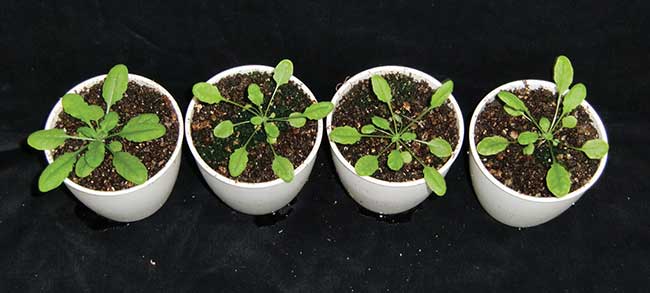If you’ve ever left a plant out of the light and had it turn a bit yellow only to return it to the light and have it turn green again, then you’ve witnessed the “plant light switch” phenomenon.
Plants have a built-in light-sensing system that responds to different times of day and to seasonal changes. Blue light plays a key role in activating plants’ responses. In fact, blue light has a revitalizing effect on plants capable of turning a light switch on and off, so to speak.

Wild Arabidopsis on the left. Three mutant strains on the right. The mutant strains have long petiole caused by insensitivity to light due to BIC1 gene overexpression. Courtesy of Minami Matsui, RIKEN Center for Sustainable Resource Science in Japan.
Many a scientist has speculated the reason lies in a process called photoreduction, a system like photosynthesis where electrons are transferred, moving energy across molecules, activating and inactivating the cryptochrome 2 (CRY2) blue light receptors.
With the help of a 450-nm blue LED light and plants’ natural CRYs, however, scientists have come up with another explanation, completely eliminating the process of photoreduction.
A research team from the RIKEN Center for Sustainable Resource Science in Japan, Fujian Agriculture and Forestry University in China, and the University of California, Los Angeles, found that when exposed to blue light, CRY2 receptors actually undergo a conformation change, taking a dimer form. This homodimer is the active form — light switch on.
In an experiment, the group screened transgenic lines of Arabidopsis — a model grass used in plant genetics — to find lines that expressed phenotypes similar to a mutant strain that does not respond to blue light. They identified lines that produced a protein called BIC1 (a blue-light inhibitor of cryptochrome 1) that corresponds to the mutant phenotype. Minami Matsui, one of the lead researchers at RIKEN, said the dimer form disappeared in the presence of BIC1 proteins — light switch off.
“We have shown that there is a desensitization mechanism where the photoactivated photoreceptor is regulated in blue light to avoid excess response,” said Matsui. “This is important as it allows plants to maintain the homeostasis of their blue light responsiveness in order to adapt to the fluctuating light environment in nature.”
Interestingly enough, these same plant CRY receptors are also found in mammals, which Matsui told Photonics Media is another focus of their newfound results.
“Blue light is used for optogenetics in animals, especially for the control of nerve signals,” said Matsui. “BIC1 proteins in plants may also control the mammalian cryptochromes and then control circadian rhythm.”
The light switch may be a little bit different from the one we’re used to turning on and off, but the concept is the same. As research continues on both plants and animals, the light switch remains turned on as long as the blue light keeps shining.